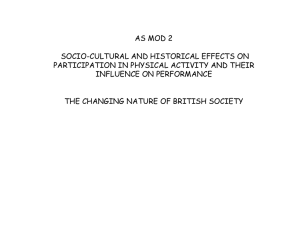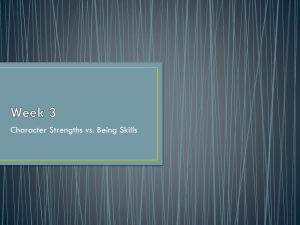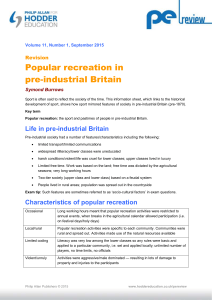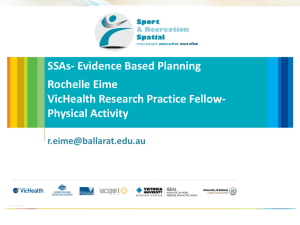AQA PHED 1 Opportunities for Participation_Historical
advertisement
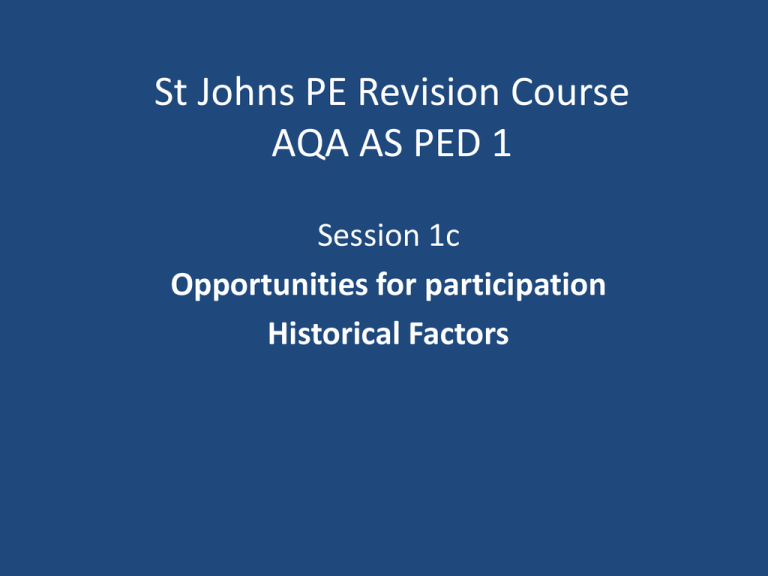
St Johns PE Revision Course AQA AS PED 1 Session 1c Opportunities for participation Historical Factors Historical, social and cultural factors • Public School and emergence of rational recreation - games • Public Schools & the concept of fair play • Development of physical activity in state schools from military drill to movement • Developments in state provision and increase in participation Public Schools & Sport Went from despised mob games to revered team sports Within 50 years What? How? Why? Mob Football - Characteristics • Violent, Drunken • Male • No specialisation • Local - rules, character • Force, strength not skill • Lacked structure – pitch, spectators, players Mob Football - Decline • Middle class values - civilising • Church • Authority crack down • Urbanisation • Public School effect • Lack of control over time - work Development of Rational Games in Public Schools Playing mob football & field sports Development of loyalty to House Status & authority given to Sixth Form Development house matches Acceptance of common rules between visiting schools and teams Skills, Tactic Development Coaching –Professionals, Blues Jan07Q2 Ans Development of internal rules/laws ‘Game Rules’ moral/ethical rules based on Christianity Development inter-school matches Development of time/facilities Public Schools 1800 - 1850 Intolerance - Tolerance Places for the ruling class, harsh environment, often uncontrolled Power of the boys - emphasis on physical prowess Futile attempts to ban mob football Arnold – Headmaster – Evangelical Christian Christian ‘gentlemen’ – Muscular Christianity Cricket, rowing were established but different versions of mob football Public Schools 1850- 1880 Tolerance – Enthusiasm Use boys enthusiasm for sport to gain social control Give VI form status in return for support – control through rules/respect VI Form – sporting ‘heroes’ – developed rules/ etiquette – athleticism - amateurism Team games for character training, group loyalty Inter House – Inter School - competitiveness Develop prowess – time, facilities, coaching! Public Schools 1800 – 1890 General Themes Occupation of free time - social control – sixth form Development of social cohesion - group loyalty Method of character development – religious connections Cult status within schools – intellectualism suffering Victorian values – service Public Schools 1800 – 1890 General Themes Physical Endeavour Moral integrity Athleticism Revival of Greek ideals Jan03Q2 Ans Reflection of religious revival/interest during period Public Schools 1800 – 1890 Into Society WHY? Old Boys University Business Church Works Teams Church Teams Colonial Service “Bit of Britain” Army All ranks teams Factors Affecting Development of Rational Recreation/Sport in Society Class Economic Rational Recreation Social Jun04Q2 Organisational Rational Rec – Social Factors Gentleman Middle Class Amateur Urbanisation W. Class Moral Reform Class Public Schools? Muscular Christianity YMCA Sunday School Church Social Boys Clubs Rational Rec – Economic factors Trade Unions Leisure Time A Right? Public Schools? Industrial Reform Economic Work Discipline Media Travel Rational Rec – Organisational Factors Organisational Codification Rules Code of Conduct June05Q1 Stringent Admin Competitive Structure Regularisation Match Days NGB Public Schools? Seasons Development of Rational Recreation/Sport in Society Gentleman Middle Class Amateur W. Class Moral Reform Class Leisure Time Trade Unions Industrial Reform Urbanisation Work Discipline Economic Social Muscular Christianity Media RR Travel Church YMCA Sunday School Organisational Boys Clubs Stringent Admin Codification Regularisation PE Change 1900 – 1980’s Main Themes Jan05Q3 Time Content Facilities Teaching Methods Cultural values 1900 Militaristic - 10 School School room room Whole Whole class, class, Command Command Control Control Discipline Discipline 1910 Therapeutic Little skill 1930 School School Hall/Yard Hall/Yard Whole Whole class class Teacher Teacher Some Some group group wk wk Health, Health, discipline, discipline, some some social social 1930 1950 Gym More Gym More pupil pupil Sport Sport Field Field control control Inc focus on on Inc focus personal personal develop develop Sp Child Sp Hall Hall Child centred centred Communit Communit Discovery. Discovery. yy Learn Learn through through physical physical Individual Social good Skill Phys develop Early mov’nt 1950 Educational Recreation -70 Movement Curriculum – Government Control 2000 NC – Content govt. directed. Method OFSTED Teacher control 1970’s 1900’s Content & method govt directed & control Govt advice on jun. content & method. Secondary – PE Colls 1950’s Content – some govt control, method teacher 1930’s 1900 – 1910 Drill v Gym What How? 1902 - Model Course: Militaristic, drill, imposed. Highly directed - tables of exercises, command style 1909 PT – Swedish gymnasticsfor health & development. Games - an extra. Little/no requirement for equipment Objections to both concepts – argument & debate Free standing – classroom, school yard NCO/Teacher in command 1900 – 1910 Drill v Gym Why? Boer War - fitness of recruits Dislike of militarism for children Concern for physical condition of the poor Influence of Swedish System and training of women teachers. Dullness of syllabus Contrast with provision for rich Facilities Jan02Q3 Ans Characteristics and Objectives of Drill Characteristics State laid down tables of exercises Marching (pretend weapons) and free standing Regimented use of commands Former NCO’s Command style teaching regimented ranks Objectives Instil discipline and obedience Improve fitness for military activity Preparation for subservient life 1910 – 1930 Gym to PT What 1919 Syllabus - Formal exercises, play, games, dance & rhythm. More formal for older children. Facilties for PT -Not compulsory Jan05Q3 Ans How Less control from teachers More initiatives from teachers Discipline still paramount Holiday/school camps 1910 – 1930 Gym to PT Why? Shock -1st W W+ fitness of recruits Improved position of women - replacing men, training Organised labour movements - anti-militaristic feeling Foreign influence - Montessori, Children - not little adults Increased pressure for games 1930 – 1960 PT to PE What? 1933 Syllabus - Two parts (11-/11+) More group work. Less whole class Recreative sport How? 1930s - Some free activity, imagination - motion stories Less teacher control Time recommendations Elementary - each day Secondary - 3 x lesson 1952 - (Primary) Moving & Growing, Planning the Programme Movement approach 1950s No set lesson plans Schemes of work from teachers PE – 1930s – 1960s PT - PE Why 2nd WW Reconstruction - better future for children 1944 Education Act - Compulsory provision Training of PE with other teachers - status Child centred learning Emphasis on skill learning Welfare state decline in medical, therapeutic aim Recreation-morale 1960’s - 1980’s PE to …….? What Junior Schools – decline in formal games How Developing affluence – rebuilding, new facilities Selling of playing fields Secondary schools PE to Phys. Recreation Movement based work Debate - width v depth. competition v co-operation Cooperative games Health concerns - HRF again! expansion of games, development of circuit tr. Control moved to teachers, schools, advisors Examinations Still traditional approaches 1960- 1980’s PE to ….? Why? Divide between skill & expression PE to Physical Recreation Outdoor education Lack of a central directive - No consensus on syllabus Mood of personal freedom in 70’s Few specialist in primary schools National Curriculum – Why? Developed between 1986-92 Games - athleticism - linked to the background of govt ministers? Control of the curriculum Worries over provision/cost No requirement on time Increasing specialisation & tech development Fears about international elite performances – Ans June03Q4 ‘Raising the Game’
